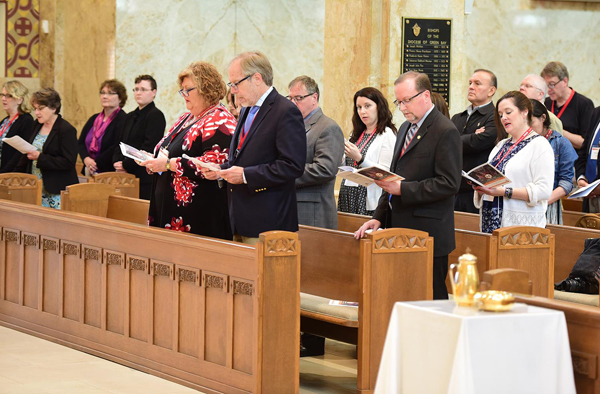It isn’t about us, it’s about Jesus
By Barb Arland-Fye
Editr
My staff sent me to the 2018 Catholic Media Conference in Green Bay with a to-do list: bring home design ideas, ask about subscription database management and get recommendations for printers of diocesan newspapers. The list remained in my backpack during the conference because another priority absorbed my attention.

Members of the Catholic Press Association attend Mass during the CPA conference in Green Bay, Wis., last week.
As communicators in a rapidly changing media environment, those of us leading Catholic diocesan and national publications must become adept at conveying news on a variety of platforms for wide-ranging audiences.
Workshop titles identified some of the challenges. “The New Areopagus — Sharing Stories of Faith in a Digital World,” borrowed from St. John Paul II’s description of communications media as the “new Areopagus” — referring to the cultural center of the ancient world where St. Paul proclaimed the Gospel.
Our diocesan newspaper maintains a loyal group of readers who prefer to read the print version of The Catholic Messenger, but another group prefers the digital version (the e-edition) or a combination of the print and e-edition or website. Other Catholics in our diocese get their news through Facebook and Instagram posts and Twitter feeds.
People of all ages are becoming familiar with Twitter — a form of social media that limits a message to 280 characters — because President Donald Trump often “tweets” his thoughts on Twitter.
How do Twitter and other social media fit into The Catholic Messenger’s efforts to educate, inform and inspire the faithful of the diocese who aren’t subscribers but could be in the future, with effective messaging?
My search got underway with the first session, “Advanced Social Media.” Our instructor observed that “we are so desperate to communicate with one another that we will do anything to connect …” The questions we should ask ourselves: What do we need to start doing, what do we need to stop doing and what do we need to keep doing? Even St. Paul had to stop once in a while to reflect on the ways in which he conveyed the Gospel of Jesus Christ to the people of his time.
Another valuable take-away from that session: in the church, social media is about empowering the committed to become communicators. That’s how the Gospel message will reach and inspire the disaffected to come to Mass. Social media can act as a bridge. Media expert Deacon Greg Kandra observed that “every story, every issue is a Catholic story.”
Keynote speaker Natasa Govekar of the Vatican’s Secretariat for Communications shared compelling insights on how Pope Francis communicates. She said the Catholic Church must be present on social media sites with the Gospel message of salvation, love and tenderness. That’s why the pope’s 47 million followers on @Pontifex prefer to see photos of him praying and reaching out in compassion to others. “It’s not about us,” she said. “It’s not even about the pope. It’s about Jesus.”
In a session on “Three Keys to Social Media,” Father Francis “Rocky” Hoffman reminded us: “Content is king.” The platforms we use to communicate won’t matter unless the content is good.
We need passion to hand on the faith. It’s the witness and works of charity that make all the difference, Bishop George Kicanas said after receiving the Catholic Press Association’s 2018 Bishop John England Award. The retired head of the Diocese of Tucson, Ariz., underscored the church’s commitment to communicate the right to life and human dignity for all, including immigrants. “We have to be a country that values human life and does not separate children from their families. We stand for life. We value life. We uphold the dignity of all human life. You get that message out.”
I was also inspired by Julie Asher, national editor of Catholic News Service, who received the St. Francis de Sales Award, the highest honor given by the Catholic Press Association. She thanked all of us, clients of CNS. “We are all workers in the vineyard; we do it every single day to tell the story of the Catholic Church.”
The to-do list remains; the insights gained at the Catholic Media Conference will help us to address it.
(Editor Barb Arland-Fye can be reached at arland-fye@davenportdiocese.org.)











